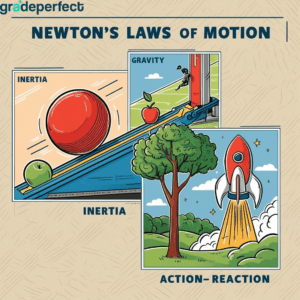All About Newton’s Laws: Student’s Guide

Newton’s Laws of Motion are essential in understanding the principles governing how objects move. These laws, formulated by Sir Isaac Newton in the late 17th century, form the foundation of classical mechanics, a core subject for students of physics.

Newton’s First Law of Motion: The Law of Inertia
The First Law, commonly known as the Law of Inertia, states: An object will remain at rest or continue to move at a constant velocity unless acted upon by an external force. This law highlights that without an outside force, an object will maintain its state of motion or rest. It’s particularly important for understanding the concept of equilibrium and how external forces affect objects.
For example, a spacecraft traveling in space will continue to move in the same direction at the same speed unless a force, such as gravity or thrust, acts upon it. The essence of the First Law is to explain that objects resist changes to their state of motion, a principle known as inertia.
For physics students, this law introduces fundamental ideas about how forces impact objects. Understanding inertia helps when studying how and why objects in motion behave the way they do, especially when external forces such as friction or air resistance are involved.
Newton’s Second Law of Motion: Force, Mass, and Acceleration
The Second Law provides the quantitative relationship between force, mass, and acceleration, which can be expressed mathematically as F = ma (Force = mass × acceleration). This law is a cornerstone in the study of physics because it allows students to calculate the force required to move an object of a particular mass at a certain acceleration.
The Second Law suggests that the larger the mass of an object, the more force is needed to move it. Additionally, for a given force, the acceleration produced will be inversely proportional to the mass. This relationship plays a crucial role in physics problems involving dynamics, where students must calculate either the force, mass, or acceleration of an object under certain conditions.
In practical terms, this law can be seen when comparing the effort needed to move a heavy object like a car versus a lighter object like a bicycle. The car requires significantly more force to accelerate due to its greater mass, while the bicycle requires far less force. This law not only provides students with a method for solving mechanical problems but also underlines the impact of net forces acting on an object, which is essential for understanding concepts such as momentum and energy.
Newton’s Third Law of Motion: Action and Reaction
Newton’s Third Law is often remembered by the phrase: For every action, there is an equal and opposite reaction. This principle explains the interactions between two objects in contact, where the force exerted by one object is met with an equal and opposite force from the other.
This law is fundamental for understanding physics concepts like force pairs. When you exert a force on an object, that object exerts an equal and opposite force back on you. This is particularly important for topics such as propulsion, where the motion of vehicles like rockets depends on the expulsion of gases in the opposite direction.
For students, mastering the Third Law is crucial for understanding how forces work in real-world applications, such as collisions or the movement of objects in fluid dynamics. The concept of action and reaction also ties into broader topics like Newton’s Third Law of planetary motion, where gravitational forces between celestial bodies are balanced by their mutual attraction.
Newton’s Laws of Motion are the first principles that physics students encounter when studying classical mechanics. These laws provide a framework for analyzing the forces and motions of objects in a variety of contexts, from simple linear motion to complex systems involving multiple forces. Students need a deep understanding of these laws, not only to solve problems in exams but also to build a foundation for more advanced topics like electromagnetism, fluid dynamics, and quantum mechanics. The clarity and simplicity of Newton’s Laws make them an ideal starting point for exploring the physical world, while their applications extend far beyond the classroom.
Overall, Newton’s First, Second, and Third Laws are the building blocks of classical mechanics. Together, they describe how forces affect the motion of objects, providing students of physics with the tools they need to analyze and predict physical phenomena in both theoretical and practical contexts. For more such bite-sized explanations of important topics and access to unlimited free resources make sure to check out Gradeperfect and BOOK YOUR FREE LIVE DEMO CLASS to get started on acing your IGCSE Physics exam.
Post Tags :
Share :

